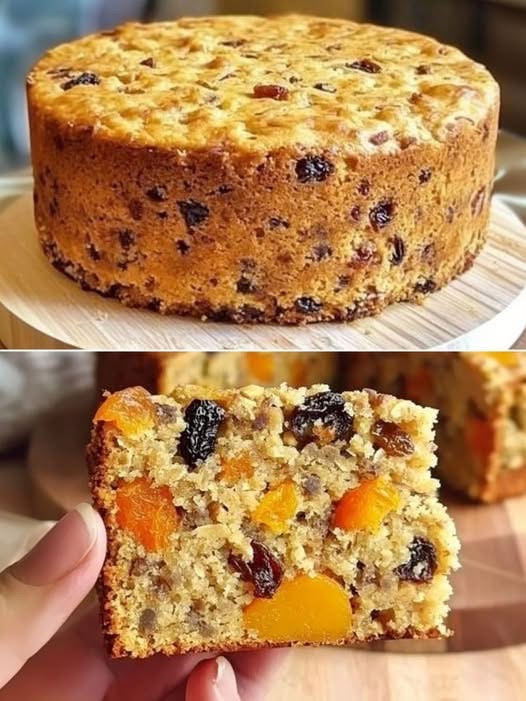Traditional Rich Fruitcake

Introduction
A rich fruitcake is a time-honored classic known for its dense texture, aromatic spices, and a medley of dried fruits and nuts. It’s often associated with Christmas, weddings, and celebrations, where it’s enjoyed for both its flavor and long shelf life. Unlike sponge cakes, this fruitcake gets better with age, making it a perfect make-ahead dessert.
History
Fruitcakes date back to ancient Rome where they were made with pomegranate seeds, pine nuts, and raisins mixed into barley mash. By the Middle Ages, preserved fruits, honey, and spices were incorporated, creating the dense, sweet version we recognize today. In England, it became a ceremonial cake for royal events, and the tradition spread globally.
Ingredients
For a large 9-inch fruitcake:
Dried Fruits (about 5 cups total):
- 1 cup raisins
- 1 cup sultanas
- 1 cup chopped dried apricots
- 1 cup chopped dried pineapple or mixed peel
- 1/2 cup dried cherries
- 1/2 cup chopped dates or prunes
Nuts (optional but traditional):
- 1 cup chopped walnuts or pecans
- 1/2 cup chopped almonds
Other Ingredients:
- 1 1/2 cups all-purpose flour
- 1/2 tsp baking powder
- 1/2 tsp baking soda
- 1 tsp ground cinnamon
- 1/2 tsp ground nutmeg
- 1/4 tsp ground cloves
- Pinch of salt
- 1 cup unsalted butter (room temperature)
- 1 cup brown sugar
- 4 large eggs
- 1/4 cup molasses or golden syrup
- 1/2 cup orange juice
- 1 tbsp vanilla extract
- Zest of 1 lemon and 1 orange
- 1/4 cup dark rum or brandy (optional, for soaking)
Preparation Method
Step 1: Soaking the Fruits (Highly Recommended)
- In a large bowl, combine all dried fruits.
- Pour the orange juice (and rum/brandy, if using) over the fruits.
- Cover and let soak overnight or up to 24 hours.
Step 2: Preheat and Prepare the Tin
- Preheat oven to 300°F (150°C).
- Line a 9-inch round cake tin with parchment paper, extending 2 inches above the top.
- Grease both the tin and paper well.
Step 3: Mixing the Batter
- In a large bowl, cream butter and sugar until light and fluffy.
- Beat in eggs one at a time, mixing well after each.
- Add molasses, vanilla extract, and citrus zest.
- In a separate bowl, sift flour, baking powder, soda, spices, and salt.
- Gradually add the flour mix to the wet mix.
- Fold in the soaked fruits and chopped nuts.
Step 4: Baking
- Spoon the thick batter into the tin and smooth the top.
- Bake for 2.5 to 3 hours, or until a skewer comes out clean.
- If the top browns too quickly, cover with foil halfway through.
Step 5: Maturing (Optional but Traditional)
- Once cooled, poke holes in the cake with a skewer.
- Spoon over 2 tbsp of brandy/rum.
- Wrap in parchment and foil, and store in a tin.
- Feed with a bit more alcohol every week for 4–6 weeks before serving.
Formation
The cake is formed by combining soaked fruits with a spiced batter, then baking slowly to retain moisture and depth of flavor. Its rich structure comes from low heat and long baking time.
Benefits
- Long shelf life – Can last months if stored properly.
- Nutrient-rich – Packed with dried fruits, nuts, and spices.
- Great for gifting – Especially during holidays.
- Improves with age – Flavor deepens over time.
- Customizable – You can tailor fruits, spices, and alcohols.
Nutrition (per slice, approx. 1/12th of cake)
- Calories: ~350
- Protein: 4g
- Fat: 15g
- Carbohydrates: 50g
- Fiber: 3g
- Sugar: 30g
- Iron: 10% DV
- Calcium: 6% DV
Lovers of Fruitcake
Fruitcake has a loyal following among:
- Holiday traditionalists
- British & Caribbean households
- Wedding planners (fruitcake is a common wedding cake base)
- Aging connoisseurs who love flavor development
- Nostalgic bakers who carry on family recipes
Conclusion
Fruitcake isn’t just dessert—it’s a slice of history, culture, and celebration. Whether you enjoy it fresh or aged, with tea or a splash of brandy, this cake brings comfort, tradition, and richness to every occasion. It is as versatile as it is classic, beloved by those who appreciate its bold flavor and dense texture.